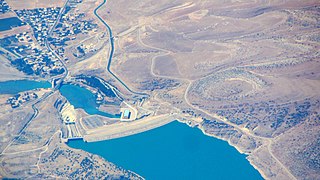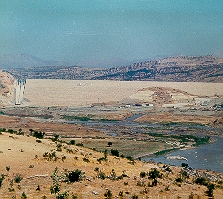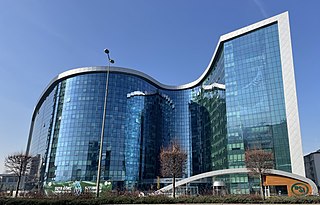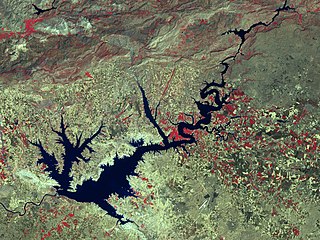
With a height of 260.5 m (855 ft) Tehri Dam is the tallest dam in India and 12th tallest dam in the world. It is a multi-purpose rock and earth-fill embankment dam on the Bhagirathi River in New Tehri, Tehri Garhwal district in Uttarakhand, India. It is the primary dam of the THDC India Ltd. and the Tehri hydroelectric complex. Phase 1 was completed in 2006. The Tehri Dam withholds a reservoir for irrigation, municipal water supply and the generation of 1,000 megawatts (1,300,000 hp) of hydroelectricity. The dam's 1,000 MW variable-speed pumped-storage scheme is currently under construction with expected commissioning of first two units in 2023.
The Atatürk Dam, originally the Karababa Dam, is the third largest dam in the world and it is a zoned rock-fill dam with a central core on the Euphrates River on the border of Adıyaman Province and Şanlıurfa Province in the Southeastern Anatolia Region of Turkey. Built both to generate electricity and to irrigate the plains in the region, it was renamed in honour of Mustafa Kemal Atatürk (1881–1938), the founder of the Turkish Republic. The construction began in 1983 and was completed in 1990. The dam and the hydroelectric power plant, which went into service after the upfilling of the reservoir was completed in 1992, are operated by the State Hydraulic Works (DSİ). The reservoir created behind the dam, called Atatürk Reservoir, is the third largest in Turkey.
The Southeastern Anatolia Project is a multi-sector integrated regional development project based on the concept of sustainable development for the 9 million people (2005) living in the Southeastern Anatolia region of Turkey. According to a governmental source, the aim of the GAP is to eliminate regional development disparities by raising incomes and living standards and to contribute to the national development targets of social stability and economic growth by enhancing the productive and employment generating capacity of the rural sector. The total cost of the project is over 100 billion Turkish lira (TL), of which 30.6 billion TL of this investment was realized at the end of 2010. The real investment was 72.6% for the end of 2010. The project area covers nine provinces which are located in the basins of the Euphrates and Tigris and in Upper Mesopotamia.

Tarbela Dam is an earth-filled dam along the Indus River in Pakistan's Khyber Pakhtunkhwa province. It is located mainly in the Haripur District of the province. It is about 20 km (10 mi) from the city of Haripur, 105 km (65 mi) northwest of Islamabad, and 125 km (80 mi) east of Peshawar. It is the largest earth-filled dam in the world. The dam is 143 metres (470 ft) high above the riverbed and its reservoir, Tarbela Lake, has a surface area of approximately 250 square kilometres (97 sq mi).

The Tabqa Dam, or al-Thawra Dam as it is also named, most commonly known as Euphrates Dam, is an earthen dam on the Euphrates, located 40 kilometres (25 mi) upstream from the city of Raqqa in Raqqa Governorate, Syria. The city of Al-Thawrah is located immediately south of the dam. The dam is 60 metres (200 ft) high and 4.5 kilometres (2.8 mi) long and is the largest dam in Syria. Its construction led to the creation of Lake Assad, Syria's largest water reservoir. The dam was constructed between 1968 and 1973 with help from the Soviet Union. At the same time, an international effort was made to excavate and document as many archaeological remains as possible in the area of the future lake before they would be flooded by the rising water. When the flow of the Euphrates was reduced in 1974 to fill the lake behind the dam, a dispute broke out between Syria and Iraq that was settled by intervention from Saudi Arabia and the Soviet Union. The dam was originally built to generate hydroelectric power, as well as irrigate lands on both sides of the Euphrates. The dam has not reached its full potential in either of these objectives.

Batman Dam is one of the 22 dams of the Southeastern Anatolia Project of Turkey, built on the Batman River, north of Batman, in southeastern of Turkey. It was constructed between 1986 and 1999. There is a hydroelectric power plant, established in 1998, at the dam, with a power output of 191.7 MW. The dam is designed to service an irrigation area of 37,744 ha. The Silvan Dam is located upstream.

The Birecik Dam, one of the 21 dams of the Southeastern Anatolia Project of Turkey, is located on the Euphrates River 60 km (37 mi) downstream of Atatürk Dam and 8 km (5.0 mi) upstream of Birecik town 80 km (50 mi) west of Province of Şanlıurfa in the southeastern region of Turkey. It was purposed for irrigation and energy production. There is a run-of-the-river hydroelectric power plant, established in 2001, at the dam, with a power output of 672MW can generate an average of 2.5 billion kWh per year. The Birecik dam is a structure consisting of a concrete gravity and clay core sandgravel fill with a height of 62.5 m (205 ft) from the foundation. It was designed by Coyne et Bellier. The total catchment area is 92,700 ha (358 sq mi). The Birecik project will be realized under the status of Build-Operate-Transfer (BOT) model.

Dicle Dam is one of the 21 dams of the Southeastern Anatolia Project of Turkey. These facilities are located within the provincial territory of Diyarbakır, at a distance of 50 kilometres to Diyarbakır city centre. More specifically, the dam and the hydroelectric power plant are located in Eğil district, at a distance of 800 metres from the point of junction of the streams of Maden Stream and Dibni to form the Tigris, and 22 kilometres downstream of the Kralkızı Dam. Construction works were started in 1986 and the dam was completed in 1997. The dam has an installed hydroelectric capacity of 110 MW and is designed to ultimately irrigate 128,080 hectares. In 2001 a water transmission line and a water treatment plant were commissioned that provided about 85% of the drinking water for the city of Diyarbakir in 2010. In 2018 a gate of the dam broke the water lever decreased and a part of a village re-emerged in the Eğil district.

Karkamış Dam is one of the 21 dams of the Southeastern Anatolia Project of Turkey. It is on the Euphrates River. The foundation of the dam was laid in 1996, and is 4.5 kilometres (2.8 mi) from the Syria border. The hydroelectric power plant has a total installed power capacity of 189 megawatts (253,000 hp).

The Keban Dam is a hydroelectric dam on the Euphrates, located in the Elazığ Province of Turkey. The dam is the first and uppermost of several large-scale dams to be built on the Euphrates by Turkey. Although the Keban Dam was not originally constructed as a part of the Southeastern Anatolia Project (GAP), it is now a fully integrated component of the project, which aims to stimulate economic development in Southeastern Turkey. Construction of the dam commenced in 1966 and was completed in 1974. Keban Dam Lake, the reservoir created by Keban Dam, has a surface area of 675 square kilometres (261 sq mi) and is reputedly the fourth-largest lake in Turkey after Lake Van, Lake Tuz, and the reservoir created by the Atatürk Dam.

Kralkızı Dam is one of the 21 dams of the Southeastern Anatolia Project of Turkey in Batman. The hydroelectric power plant has a total installed power capacity of 94 MW. The dam was constructed between 1985 and 1997.

The Ilısu Dam is a concrete-face rock-fill dam on the Tigris near the village of Ilısu and along the border of Mardin and Şırnak Provinces in Turkey. It is one of the 22 dams of the Southeastern Anatolia Project and its purpose is hydroelectric power production, flood control and water storage. When operational, the dam will support a 1,200 MW power station and will form a 10.4 billion m3 reservoir. Construction of the dam began in 2006 and was originally expected to be completed by 2016. As part of the project, the much smaller Cizre Dam is to be constructed downstream for irrigation and power. The dam has drawn international controversy, because it will flood portions of ancient Hasankeyf and necessitate the relocation of people living in the region. Because of this, the dam lost international funding in 2008. Most historical structures in Hasankeyf were moved to the new Hasankeyf prior to the filling of the dam. The dam began to fill its reservoir in late July 2019. Due to rainfall, the dam has achieved water levels up to 100m above the river bed and stored 5 billion cubic meters of water. The water level had reached an elevation of 498.2m on 1 April 2020.
The Sır Dam is an arch dam on the Ceyhan River in Kahramanmaraş Province of southern Turkey. There is a hydroelectric power plant, established in 1991, at the dam, with a power output of 285 MW.

Silvan Dam is an embankment concrete-face rock-fill currently under construction on the Batman River in the district of Silvan, Diyarbakır Province in southeastern Turkey. It is part of the Southeastern Anatolia Project and located upstream of the Batman Dam. Construction began on 26 July 2011 and is expected to be complete in 2022. The purpose of the dam is hydroelectric power production and irrigation. It is designed to irrigate an area of 245,000 ha. The power station will have an installed capacity of 160 MW.

Aslantaş Dam is an embankment dam on Ceyhan River in Osmaniye Province, southern Turkey, built between 1975 and 1984.
The Cirata Dam is an embankment dam on the Citarum River in West Java, Indonesia. It is located 100 km (62 mi) southeast of Jakarta. It was constructed between 1984 and 1988 for the primary purpose of hydroelectric power generation. Other purposes include flood control, aquaculture, water supply and irrigation. The 125 m (410 ft) tall concrete-face rock-fill dam is situated just before a sharp bend in the river and withholds a reservoir with a gross storage capacity of 2,165,000,000 m3 (1,755,194 acre⋅ft). The reservoir has a surface area of 62 km2 (24 sq mi) which caused the relocation of 6,335 families. The dam's power station is located on the north side of the river bend and contains eight 126 MW Francis turbine-generators. It has a total installed capacity of 1,008 MW and an annual generation of 1,426 GWh. The power station was completed in two phases, the second was completed in 1998. It serves mostly as a peaking power plant and is the largest hydroelectric power station in Indonesia. The construction of the dam resulted in involuntary resettlement of 56,000 people.

The Saguling Dam is an embankment dam on the headwater of Citarum River in West Java, Indonesia. It is located 26 km (16 mi) west of Bandung. Construction began in 1983. The reservoir had filled by 1985 and the first generator was operational in 1986. The primary purpose of the dam is hydroelectric power generation but it also provides for water supply and aquaculture. The 99 m (325 ft) tall dam is rock-fill embankment-type with watertight core that withholds a reservoir with a capacity of 2,750,000,000 m3 (2,229,461 acre⋅ft). Its power station has 4 x 175 MW Francis turbine generators with an installed capacity of 700 MW. Including land acquisition, the cost of the dam with power plant was about $US 663 million. The installed capacity of the power plant might be expanded to 1,400 MW in the future. The construction of the dam resulted in displacement of nearly 60,000 people.
Garzan Dam is an embankment dam on the Garzan River 9 km (5.6 mi) northeast of Kozluk in Batman Province, Turkey. It is part of the Southeastern Anatolia Project and has a primary purpose of hydroelectric power generation and irrigation. Surveys for the dam were completed in 2008, construction began in 2009 and the dam began to impound its reservoir in October 2012. The power plant has an installed capacity of 49 MW. The irrigation works remain under construction and are expected to irrigate an area of 40,000 ha when complete. The dam was awarded to FERNAS Energy Electricity Generation Co. Inc. in 2011 under a build–operate–transfer basis.

Hydroelectricity is a major source of electricity in Turkey, due to its mountainous landscape and many rivers. The country's main river basins are the Euphrates and Tigris. Over 700 hydropower plants have been built, and they make up about 30% of the country's electricity generating capacity. Annual generation varies greatly, and in rainy years lots of hydroelectric power can be generated. Government policies have generally supported building dams, but some are controversial in neighbouring countries, and some raise concerns about damage to the environment and wildlife.

The Atatürk Reservoir is a reservoir on the Euphrates, created by the Atatürk Dam in Turkey. It is located between Adıyaman, Şanlıurfa, and Diyarbakır provinces. The reservoir has a surface area of 817 km² and a volume of 48.5 cubic kilometers, making it the third largest lake in the country after Lake Van and Lake Tuz. It was formed between 1990–1992. The reservoir water level touched 535 m (1,755 ft) amsl in 1994. Since then, it varies between 526 and 537 m amsl. The full reservoir level is 542 m (1,778 ft), and the minimum operation level is 526 m (1,726 ft) amsl.


















